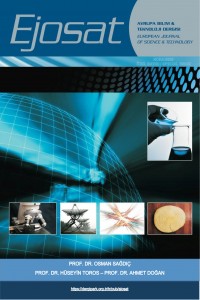Abstract
EOG is based on the electrical potential difference resulting from polarization between the cornea of the eye and the retina. This potential difference is created by the regular negative electrical dipole on the back of the eye and the regular positive electrical dipole on the front of the eye and is detected by the electrodes placed on the face. Follow-up of eye movements can provide convenience to many patients and to work in many medical fields. This study was carried out to enable physically disabled individuals to keep up with technology and to facilitate computer use. In this study, an electronic circuit design was used to obtain the EOG signal. In addition, various functional movements of the eye in the obtained signal were detected by the designed circuit and observed in the oscilloscope and computer environment. In addition, following the movements of the computer is ensured to follow the eye movements with the appropriate interface where the signal is integrated. According to detected EGO signals, in line with the developed algorithm, subjects with physical disabilities can provide computer control.
Keywords
References
- Brahmaiah, V. P., Sai, Y. P., & Prasad, M. G. (2017, January). Data Acquisition System of Electrooculogram. In 2017 IEEE 7th International Advance Computing Conference (IACC) (pp. 716-721). IEEE.
- Banerjee, A., Konar, A., Tibarewala, D. N., & Janarthanan, R. (2012, July). Detecting eye movement direction from stimulated Electro-oculogram by intelligent algorithms. In 2012 Third International Conference on Computing, Communication and Networking Technologies (ICCCNT'12) (pp. 1-6). IEEE.
- Webster, J. G. (Ed.). (1999). The Measurement, Instrumentation, and Sensors: Handbook. Springer Science & Business Media.
- Tabkara, M., Latifoğlu, F., Ceran, K., Çavga, S. H., Yaprak, M., & Altintop, Ç. G. (2017, October). Electrooculography based font and punto analysis. In 2017 Medical Technologies National Congress (TIPTEKNO) (pp. 1-4). IEEE.
- Usakli, A. B., Gurkan, S., Aloise, F., Vecchiato, G., & Babiloni, F. (2010). On the use of electrooculogram for efficient human computer interfaces. Computational intelligence and neuroscience, 2010.
- Yıldız, M. (2011). EOG Tabanlı Yazı Yazma Sistemleri İçin Yeni Bir Kodlama Tekniği. In IEEE 19th Signal Processing and Communications Applications Conference (pp. 90-93).
- Ayvaz, A., & Ertaş, G. Eyleyicileri Kontrol Etmek için EOG Temelli bir Elektronik Devre Tasarımı Design of an EOG Based Electronic Circuit to Control Actuators.
- Esas, M. Y., & Latifo, F. (2015). Bilgisayar Tabanlı İki Kanallı Elektrookülografi Cihazı Tasarımı ve Göz Hareketlerinin Takibi Computer-Based Design with Dual Channel Device Electrooculography and Eye Movement Tracking.
- Ülkütaş, H. Ö. (2015). Eog’nin Kodlanmasina Dayanan Bilgisayar Tabanli Gözle Yazi Yazma Sistemi Geliştirilmesi. Başkent Üniversitesi.
- Boylestad, R. L. (2009). Electronic devices and circuit theory. Pearson Education India.
- Instruments, T., & Sensors, L. P. C. T. (1999). LM358 Datasheet. Texas Instruments Incorporated.
- Devices, A. (1999). AD620 Datasheet. Low cost, Low Power Instrumentation Amplifier.
- Instruments, T. (1998). Lm741 operational amplifier. LM741 datasheet, May.
Abstract
EOG gözün korneası ile retinası arasındaki kutuplaşmalar sonucu ortaya çıkan elektriksel potansiyel farkına dayanır. Bu potansiyel fark gözün arka tarafındaki düzenli negatif elektriksel dipol ve gözün ön tarafındaki düzenli pozitif elektriksel dipol tarafından oluşturulur ve yüze yerleştirilen elektrotlar tarafından algılanır. Göz hareketlerinin takibi günümüzde birçok hastaya ve pek çok medikal alandaki çalışmaya kolaylık sağlayabilecektir. Bedensel engelli bireylerin teknolojiye ayak uydurmalarını sağlamak ve bilgisayar kullanımını kolaylaştırmak projenin genel amacıdır. Bu çalışmada EOG sinyalini elde etmeye yarayan elektronik devre tasarımı gerçekleştirilmiştir. Ayrıca elde edilen sinyalde gözün çeşitli fonksiyonel hareketleri, tasarlanan devre ile tespit edilmiş ardından osiloskopta ve bilgisayar ortamında gözlemlenmiştir. Son olarak bilgisayar ortamında işlenen sinyalin entegre edildiği uygun arayüz ile göz hareketlerinin takibi yapılmıştır. Bu takip sayesinde geliştirilen algoritma ile bedensel engelli bireylerin bilgisayar kontrolü yapabilmesi sağlanmıştır.
Keywords
References
- Brahmaiah, V. P., Sai, Y. P., & Prasad, M. G. (2017, January). Data Acquisition System of Electrooculogram. In 2017 IEEE 7th International Advance Computing Conference (IACC) (pp. 716-721). IEEE.
- Banerjee, A., Konar, A., Tibarewala, D. N., & Janarthanan, R. (2012, July). Detecting eye movement direction from stimulated Electro-oculogram by intelligent algorithms. In 2012 Third International Conference on Computing, Communication and Networking Technologies (ICCCNT'12) (pp. 1-6). IEEE.
- Webster, J. G. (Ed.). (1999). The Measurement, Instrumentation, and Sensors: Handbook. Springer Science & Business Media.
- Tabkara, M., Latifoğlu, F., Ceran, K., Çavga, S. H., Yaprak, M., & Altintop, Ç. G. (2017, October). Electrooculography based font and punto analysis. In 2017 Medical Technologies National Congress (TIPTEKNO) (pp. 1-4). IEEE.
- Usakli, A. B., Gurkan, S., Aloise, F., Vecchiato, G., & Babiloni, F. (2010). On the use of electrooculogram for efficient human computer interfaces. Computational intelligence and neuroscience, 2010.
- Yıldız, M. (2011). EOG Tabanlı Yazı Yazma Sistemleri İçin Yeni Bir Kodlama Tekniği. In IEEE 19th Signal Processing and Communications Applications Conference (pp. 90-93).
- Ayvaz, A., & Ertaş, G. Eyleyicileri Kontrol Etmek için EOG Temelli bir Elektronik Devre Tasarımı Design of an EOG Based Electronic Circuit to Control Actuators.
- Esas, M. Y., & Latifo, F. (2015). Bilgisayar Tabanlı İki Kanallı Elektrookülografi Cihazı Tasarımı ve Göz Hareketlerinin Takibi Computer-Based Design with Dual Channel Device Electrooculography and Eye Movement Tracking.
- Ülkütaş, H. Ö. (2015). Eog’nin Kodlanmasina Dayanan Bilgisayar Tabanli Gözle Yazi Yazma Sistemi Geliştirilmesi. Başkent Üniversitesi.
- Boylestad, R. L. (2009). Electronic devices and circuit theory. Pearson Education India.
- Instruments, T., & Sensors, L. P. C. T. (1999). LM358 Datasheet. Texas Instruments Incorporated.
- Devices, A. (1999). AD620 Datasheet. Low cost, Low Power Instrumentation Amplifier.
- Instruments, T. (1998). Lm741 operational amplifier. LM741 datasheet, May.
Details
| Primary Language | Turkish |
|---|---|
| Subjects | Engineering |
| Journal Section | Articles |
| Authors | |
| Publication Date | August 15, 2020 |
| Published in Issue | Year 2020 Ejosat Special Issue 2020 (HORA) |


